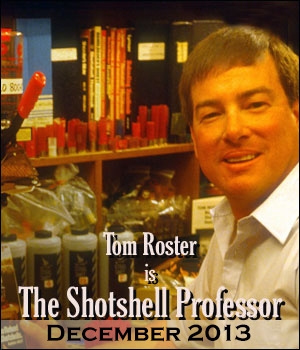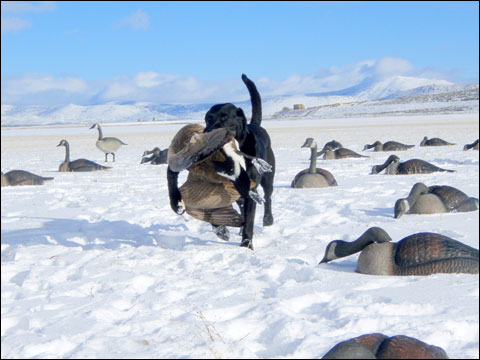Why Winter Requires Ammo Changes

“Late season birds are tougher to kill because of their thicker feathers and heavier layers of fat and down.” How many times have you heard that? I’m sorry, but it’s not true.
As fall wears on into winter, wild waterfowl and upland birds have progressively LESS access to food. This is due principally to snow cover. So fat layers and muscles of wild game birds do not get thicker or heavier as fall hunting seasons transcend into winter.
As far as the birds being “more feathered-out” late in the season, that’s another fallacy. By November 1st they have all the head, neck, body and flight feathers they’re ever going to get. Now, they might have a wee bit more insulating down. But in my necropsies of thousands of waterfowl and pheasants, down has never proven to be a significant pellet penetration inhibitor regardless of thickness. Bottom line: there’s nothing anatomically or physiologically significantly different about wild game birds during late fall and winter which makes them harder to kill.
What is changing as the season wears on is that average daily temperatures decline. All shotshell ammunition – factory or reloaded – sheds velocity quicker and patterns open more as temperature drops. The atmosphere also becomes denser. The denser the atmosphere, the more resistance confronts the projectiles. The denser the medium a projectile has to pass through, the more quickly it slows down. If the projectile is deformed (as would happen to the vast majority of lead pellets and the pellets in soft, nontoxic shot types such as bismuth and several plastic-tungsten alloy types), it will diverge from the point of aim at an angle ever greater the denser the atmosphere becomes.
The other thing that is changing – as far as wild birds are concerned – is that the survivors are becoming increasingly more wary. Therefore, they tend to flush further from the gun (upland hunting) and decoy progressively poorer (waterfowl hunting) the later in the season we get. The result is that the average distance of shots taken during late season on wild birds tends to be significantly longer than the average distance of shots early in the season. And as distances increase, pattern density and per-pellet retained energy of all shotshell loads decrease exponentially.
 Cold weather decreases the ballistics of all shotshell loads in terms of both patterns and per-pellet retained energy. Moving up to a one size larger pellet during cold weather is the simplest solution to counteract this performance loss.
Cold weather decreases the ballistics of all shotshell loads in terms of both patterns and per-pellet retained energy. Moving up to a one size larger pellet during cold weather is the simplest solution to counteract this performance loss. How much of a change occurs in patterns from warm weather to cold? This is a function of choke. As a general rule of thumb, I have always found patterns from an improved cylinder choke open up more from the effects of cold weather than a full choke. This change can be as much as 15% more open patterns for some lead loads when fired through a skeet or improved cylinder choke at distances of 40 yards, and 20% or more when fired through the same choke at distances of 50 yards. From my testing these same loads when fired through a full choke will generally lose something more like 8% to 10% at 40 yards and about 15% at 50 yards. These declines in pattern density occur as outdoor temperatures drop below 40° F, and especially below 20° F. This explains why shotgunners who take the time to pattern test are sometimes miffed when they see that their pet load which produced pattern quality X during the summer, suddenly starts producing lower pattern values during the late fall/winter.
Also as temperatures drop, primers and propellants do not generate as much energy. Thus velocities decline. Generally speaking, those shotshell loads featuring slow burning propellants and low chamber pressure suffer more velocity loss from the effects of declining temperature, than do loads with faster burning propellants and higher chamber pressure levels. All heavy lead and nontoxic shotshell loads tend to contain slow burning propellants, so they’re especially vulnerable. It is not unusual to see such loads losing as much as 75 feet per second in instrumental velocity as the temperature declines from 70° F to 20° F.
Many waterfowlers, pheasant and grouse hunters switch to larger pellets later in the season. Commonly they go to a one size larger pellet to keep per-pellet energy up during cold weather. For example, as a gross rule of thumb a No. 4 lead pellet at 20° F behaves about like a No. 5 lead at 60° F. Same thing for a No. 1 steel versus a No. 2 steel, or a No. BBB steel for a No. BB steel. It is indeed, therefore, a good move during late fall and winter months to go up one pellet size to compensate for the pellet energy eroding effects of a denser atmosphere.
In summary, the culprit in late season shooting is not that the birds are harder to kill: it’s that shotshell ammunition performs more poorly and wild birds fly further from the gun. The solution is to simply go to a one size larger pellet together with a willingness to decrease maximum shooting distances.
Copyright 2013 by Tom Roster. All Rights Reserved. This material may not be published, broadcast, rewritten or redistributed.
Tom Roster is an independent ballistics consultant and author specializing in the design and testing of shotshell loads for U.S. shotshell and reloading components manufacturers. He is a court-recognized shotshell/shotgun expert witness. Tom was formerly the Ballistics Research Director at Oregon Institute of Technology and then served as a Ballistics Specialist for the Dept. of the Interior. In these capacities he designed and administered the world’s six most extensive lead versus nontoxic shot duck, goose, pheasant and dove shooting tests ever conducted. He then co-authored their peer-reviewed scientific reports. Roster spends about 100 days afield each year testing lead and nontoxic hunting and target shotshell loads, then traveling worldwide reporting on his findings to industry and wildlife professionals, hunters and shooters, and in his writings for various shotgunning magazines. Contact him in Oregon at (541) 884-2974,tomroster@charter.net.

Tom Roster is an independent ballistics consultant and author specializing in the design and testing of shotshell loads for U.S. shotshell and reloading components manufacturers. He is a court-recognized shotshell/shotgun expert witness. Tom was formerly the Ballistics Research Director at Oregon Institute of Technology and then served as a Ballistics Specialist for the Dept. of the Interior. In these capacities he designed and administered the world’s six most extensive lead versus nontoxic shot duck, goose, pheasant and dove shooting tests ever conducted. He then co-authored their peer-reviewed scientific reports. Roster spends about 100 days afield each year testing lead and nontoxic hunting and target shotshell loads, then traveling worldwide reporting on his findings to industry and wildlife professionals, hunters and shooters, and in his writings for various shotgunning magazines. Contact him in Oregon at (541) 884-2974, tomroster@charter.net.


Comments